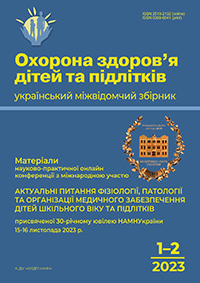Association of single-nucleotide variants of the glucagon-like peptide-1 receptor gene with sweet taste preferences in children with obesity
DOI:
https://doi.org/10.53457/2023.1-2.8Keywords:
single nucleotide gene variants, sweet taste preferences, eating behavior, obesity, physiological body weightAbstract
Background. Single nucleotide variants (SNVs) of the glucagon-like peptide-1 receptor (GLP1R) gene determine impaired stimulation of anorexigenic neurons and inhibition of orexigenic neurons, which leads to a decrease in the feeling of satiety with an increase in the feeling of hunger and potential consumption of food. The aim of the study: to investigate the association level of SNVs of the GLP1R gene and sweet taste preference in the development of obesity among children. Materials and methods. 316 children aged 6-18 years were examined. The main group (n=252) was represented by children with obesity. The control group (n=64) consisted of children with physiological body weight. Randomly selected 52 obese children underwent whole genome sequencing (CeGat, Germany). Taste preferences were assessed for all children using the Food and Beverage Preference Questionnaire. Static analysis included variation and correlation analysis, method for assessing the spread of data (estimation of dispersion). The critical value of the level of statistical significance (p) for all types of analysis was accepted at the level of p<0.05 (5%). Results: The average level of sweet taste preference among obese children was 3.38±0.06 points, while in the control group it was 3.74±0.05 points, p=0.000013. 14 SNVs of the GLP1R gene were found among obese children: rs761386, rs1042044, rs1126476, rs2235868, rs3765468, rs61754624, rs6918287, rs6923761, rs10305420, rs1030542 1, rs10305457, rs10305492, rs10305493, rs1472308929. SNVs of the GLP1R gene were highly associated with obesity, respectively in ascending order: rs1126476 (40.4%), rs2235868 (42.3%), rs1042044 (42.3%), rs6918287 (55.8%). The highest correlation between sweet taste preference was observed for SNV rs6918287 (r=0.61, p<0.05), when comparing 14 SNVs of the GLP1R gene. Conclusions: In children with obesity, a violation of sweet taste preferences is noted, which is highly associated with the presence of SNV rs6918287 of the GLP1R gene.
References
Sartor F, Donaldson LF, Markland DA, et al. Taste perception and implicit atti-tude toward sweet related to body mass index and soft drink supplementation. Appetite. 2011;57:237–246. doi: 10.1016/j.appet.2011.05.107.
Nishihara T, Nozaki T, Sawamoto R, et al. Effects of Weight Loss on Sweet Taste Preference and Palatability following Cognitive Behavioral Therapy for Women with Obesity. Obes. Facts. 2019;12:529–542. doi: 10.1159/000502236.
Jensterle M, Rizzo M, Janez A. Glucagon-Like Peptide 1 and Taste Perception: From Molecular Mechanisms to Potential Clinical Implications. Int J Mol Sci. 2021;22(2):902. Published 2021 Jan 18. doi:10.3390/ijms22020902.
Jensterle M, Rizzo M, Janez A. Glucagon-Like Peptide 1 and Taste Perception: From Molecular Mechanisms to Potential Clinical Implications. Int J Mol Sci. 2021 Jan 18;22(2):902. doi:10.3390/ijms22020902.
Takai S, Yasumatsu K, Inoue M, et al. Glucagon-like peptide-1 is specifically involved in sweet taste transmission. FASEB J. 2015 Jun;29(6):2268-80. doi: 10.1096/fj.14-265355.
Jilani HS, Intemann T, Bogl LH, et al. I.Family consortium. Familial aggregation and socio-demographic correlates of taste preferences in European children. BMC Nutr. 2017 Dec 6;3:87. doi:10.1186/s40795-017-0206-7.
Hongshan J, Rong L, Shou-Wei D, et al. Skewer: a fast and accurate adapter trimmer for next-generation sequencing paired-end reads. In BMC Bioinformatics. 2014;15:182. doi:10.1186/1471-2105-15-182.
Li H, Durbin R. Fast and accurate short read alignment with Burrows-Wheeler transform. Bioinformatics. 2009;25(14):1754–1760. doi: 10.1093/bioinformatics/btp324.
Mose LE, Wilkerson MD, Hayes DN, et al. ABRA: improved coding indel detection via assembly-based realignment. Bioinformatics. 2014;30(19):2813-2815. doi: 10.1093/bioinformatics/btu376.
Deelen P, Bonder MJ, van der Velde KJ, et al. Genotype harmonizer: automatic strand alignment and format conversion for genotype data integration. BMC Res Notes. 2014;7:901. doi:10.1186/1756-0500-7-901.
Landrum MJ, Lee JM, Benson M, et al. ClinVar: improving access to variant interpretations and supporting evidence. Nucleic Acids Res. 2018 Jan 4;46(D1):D1062-D1067. doi: 10.1093/nar/gkx1153.
Karczewski KJ, Francioli LC, Tiao G, et al. The mutational constraint spectrum quantified from variation in 141,456 humans. Nature. 2020;581:434–43.
Ulintz PJ, Wu W, Gates CM. Bioinformatics Analysis of Whole Exome Sequencing Data. Methods Mol Biol. 2019;1881:277-318. doi:10.1007/978-1-4939-8876-1_21.
Buniello A, MacArthur JAL, et al. The NHGRI-EBI GWAS Catalog of published genome-wide association studies, targeted arrays and summary statistics 2019. Nucleic Acids Res. 2019 Jan 8;47(D1):D1005-D1012. doi: 10.1093/nar/gky1120.
RefSeq: NCBI Reference Sequence Database. Available at: https:www.ncbi.nlm.nih.govrefseq. Accessed 2 November 2023.
Archer NS, Shaw J, Cochet-Broch M, et al. Obesity is associated with altered gene expression in human tastebuds. Int. J. Obes. 2019;43:1475–1484. doi: 10.1038/s41366-018-0303-y.
Abaturov A, Nikulina A. Disoders of eating behavior at different phenotypes of obesity in children. Child's health. 2020;5(15):55-59. doi: 10.22141/2224-0551.15.5.2020.211441.
Abaturov A, Nikulina A. Taste preferences and obesity. Pediatria Polska - Polish Journal of Paediatrics. 2022;97(1):1-6. doi:10.5114/polp.2022.115139.
Wessel J, Chu AY, Willems SM, et al. Low-frequency and rare exome chip variants associate with fasting glucose and type 2 diabetes susceptibility. Nat Commun. 2015 Jan 29;6:5897. doi:10.1038/ncomms6897.
Downloads
Published
Issue
Section
License
Copyright (c) 2024 А. О. Нікуліна

This work is licensed under a Creative Commons Attribution-NonCommercial-NoDerivatives 4.0 International License.

